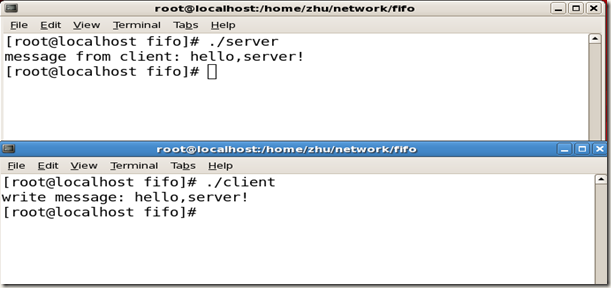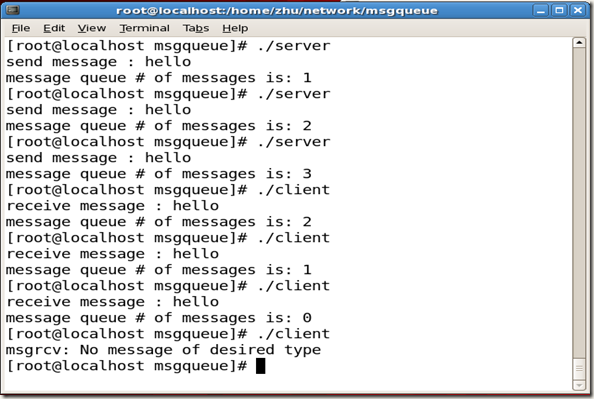进程间通信和同步:pipe、FIFO、消息队列、信号量、共享内存、信号
一、半双工管道(pipe)

关于管道详细介绍可参考http://www.cnblogs.com/nufangrensheng/p/3560130.html。
1、管道实现父子进程间通信实例:
/* pipe.c */
#include <unistd.h>
#include <stdio.h>
#include <limits.h>
#include <sys/types.h>
#include <errno.h>
#include <stdlib.h>
#define MAXLINE 1024
int
main(void)
{
int fd[2], pid;
char buf[MAXLINE]; if(pipe(fd) < 0)
{
perror("pipe error");
exit(1);
} if((pid = fork()) < 0)
{
perror("fork error");
exit(1);
}
else if(pid == 0) /* child */
{
close(fd[1]); /* read from parent */ if(read(fd[0], buf, MAXLINE) < 0)
{
perror("read error");
exit(1);
}
printf("read from parent: %s\n", buf);
}
else /* parent */
{
close(fd[0]); /* send to child */ if(write(fd[1], "hello, i am your parent", 24) != 24)
{
perror("write error");
exit(1);
}
printf("send to child OK!\n");
wait(NULL);
}
}
编译运行结果:

2、管道实现父子进程间同步实例:
/* pipe_sync.c */
#include <sys/types.h>
#include <errno.h>
#include <unistd.h>
#include <stdio.h>
#include <stdlib.h>
#include <unistd.h>
#define BUFSIZE 1024 int fd1[2], fd2[2];
char c; void tell_wait()
{
if(pipe(fd1) < 0 || pipe(fd2) < 0)
{
perror("pipe error");
exit(1);
}
} void tell_parent()
{
if(write(fd1[1], "c", 1) != 1)
{
perror("write error");
exit(1);
}
}
void wait_parent()
{
if(read(fd2[0], &c, 1) != 1)
{
perror("read error");
exit(1);
}
if(c != 'p')
{
printf("wait_parent: invalid data\n");
exit(1);
}
}
void tell_child()
{
if(write(fd2[1], "p", 1) != 1)
{
perror("write error");
exit(1);
}
}
void wait_child()
{
if(read(fd1[0], &c, 1) != 1)
{
perror("read error");
exit(1);
}
if(c != 'c')
{
printf("wait_child: invalid data");
exit(1);
}
} int
main(void)
{
int pid;
tell_wait();
if((pid = fork()) < 0)
{
perror("fork error");
exit(1);
}
else if(pid == 0)
{
printf("child: first\n");
tell_parent();
}
else
{
wait_child();
printf("parent: after child\n");
}
return(0);
}
编译运行结果:

二、命名管道(FIFO)

在文件系统中命名管道是以设备特殊文件的形式存在的。
不同的进程可以通过命名管道共享数据。
关于FIFO详细介绍可参考http://www.cnblogs.com/nufangrensheng/p/3561632.html。
FIFO实现进程间通信实例:
/***************************
* **** FIFO server**********
***************************/
#include <stdio.h>
#include <stdlib.h>
#include <errno.h>
#include <unistd.h>
#include <fcntl.h>
#include <sys/types.h>
#include <sys/stat.h> #define FIFO "/home/zhu/network/fifo/myfifo"
#define OPEN_MODE O_RDONLY int
main(void)
{
int fifofd;
char buf[80];
unlink(FIFO); /* 防止FIFO已存在 */
if(mkfifo(FIFO, 0777) == -1)
{
perror("mkfifo");
exit(1);
} if((fifofd = open(FIFO, OPEN_MODE)) < 0)
{
perror("open");
exit(1);
} read(fifofd, buf, sizeof(buf));
printf("message from client: %s\n", buf); close(fifofd); return(0);
}
/***************************
* **** FIFO client**********
***************************/
#include <stdio.h>
#include <stdlib.h>
#include <errno.h>
#include <unistd.h>
#include <fcntl.h>
#include <sys/types.h>
#include <sys/stat.h> #define FIFO "/home/zhu/network/fifo/myfifo"
#define OPEN_MODE O_WRONLY
int
main(void)
{
int fifofd;
char s[] = "hello,server!"; if((fifofd = open(FIFO, OPEN_MODE)) < 0)
{
perror("open");
exit(1);
} write(fifofd, s, sizeof(s));
printf("write message: %s\n", s); close(fifofd); return(0);
}
编译成功后,我们首先运行服务器(创建FIFO,等待客户发来消息,此时FIFO服务器阻塞):

接着我们在另一个终端窗口运行客户程序,如下图所示,可以看出客户端已成功发送,服务器端也成功接收:

三、消息队列
消息队列是内核地址空间中的内部链表,通过Linux内核在各个进程之间传递内容。
关于消息队列详细介绍可参考http://www.cnblogs.com/nufangrensheng/p/3561820.html。
消息队列实现进程间通信实例:
/***************************
*******MSGQ server**********
***************************/
#include <sys/msg.h>
#include <sys/ipc.h>
#include <stdio.h>
#include <stdlib.h>
#include <errno.h>
#include <fcntl.h>
#include <unistd.h>
#include <sys/types.h>
#include <sys/stat.h> #define msqpath "/home/zhu/network/msgqueue/msq"
#define proj_id 'b' struct mymesg {
long mtype;
char mtext[512];
}; int
main(void)
{
key_t key;
int msqid;
struct msqid_ds buf;
struct mymesg msg1;
msg1.mtype = 1;
sprintf(msg1.mtext, "hello"); if((key = ftok(msqpath, proj_id)) < 0)
{
perror("ftok");
exit(1);
} if((msqid = msgget(key, IPC_CREAT)) < 0)
{
perror("msgget");
exit(1);
} if(msgsnd(msqid, &msg1, sizeof(msg1), IPC_NOWAIT) < 0)
{
perror("msgsnd");
exit(1);
}
printf(“send message : hello\n”);
if(msgctl(msqid, IPC_STAT, &buf) < 0)
{
perror("msgctl");
exit(1);
}
printf("message queue # of messages is: %d\n", buf.msg_qnum);
return(0); }
/*****************************
**********MSGQ client*********
*****************************/
#include <sys/msg.h>
#include <sys/ipc.h>
#include <stdio.h>
#include <stdlib.h>
#include <errno.h>
#include <fcntl.h>
#include <unistd.h>
#include <sys/types.h>
#include <sys/stat.h> #define msqpath "/home/zhu/network/msgqueue/msq"
#define proj_id 'b' struct mymesg {
long mtype;
char mtext[512];
}; int
main(void)
{
key_t key;
int msqid;
struct msqid_ds buf;
struct mymesg msg1; if((key = ftok(msqpath, proj_id)) < 0)
{
perror("ftok");
exit(1);
} if((msqid = msgget(key, IPC_EXCL)) < 0)
{
perror("msgget");
exit(1);
} if(msgrcv(msqid, &msg1, sizeof(msg1), 0, IPC_NOWAIT) < 0)
{
perror("msgrcv");
exit(1);
}
printf("receive message : %s\n", msg1.mtext); if(msgctl(msqid, IPC_STAT, &buf) < 0)
{
perror("msgctl");
exit(1);
}
printf("message queue # of messages is: %d\n", buf.msg_qnum);
return(0); }
编译后运行结果如下:

四、信号量
信号量是一种计数器,用来控制对多个进程共享的资源所进行的访问。它们常常被用作一个锁机制,在某个进程正在对特定资源进行访问时,信号量可以防止另一个进程去访问它。
关于信号量详细介绍可参考http://www.cnblogs.com/nufangrensheng/p/3562046.html。
信号量实现资源控制实例:
#include <sys/types.h>
#include <linux/sem.h>
#include <linux/ipc.h>
#include <sys/stat.h>
#include <fcntl.h>
#include <stdio.h>
#include <stdlib.h>
#include <errno.h>
#include <unistd.h> #define sempath "/home/zhu/network/semaphore/sem"
#define proj_id 'c' int
main(void)
{
int semid, i;
key_t key;
union semun sem, getsem;
sem.val = 3; if((key = ftok(sempath, proj_id)) < 0)
{
perror("ftok");
exit(1);
} if((semid = semget(key, 1, IPC_CREAT)) < 0)
{
perror("semget");
exit(1);
} semctl(semid, 0, SETVAL, sem); semctl(semid, 0, GETVAL, sem);
printf("# of usable semphore: %d\n", sem.val); struct sembuf sops = {0, -1, IPC_NOWAIT};
for(i = 0; i < 4; i++)
{
printf(“%dth:”,i+1);
fflush(stdout);
if(semop(semid, &sops, 1) < 0)
{
perror("semop");
exit(1);
}
printf("ask for one semaphore:success!\n");
}
return(0);
}
编译运行结果如下(因为我们把信号量值设置为3,所以第四次资源请求失败):

注意,在上面的程序中,包含的头文件#include <linux/sem.h> 和#include <linux/ipc.h>。而不是#include <sys/sem.h> #include <sys/ipc.h>。否则出现“storage of size of 'sem' isn't know”的错误。详细介绍请参考http://hi.baidu.com/yuhongyangcn/item/f52545b33c1b55a1eaba93ac。
关于POSIX信号量详情可参考http://www.cnblogs.com/nufangrensheng/p/3564306.html。
注意使用POSIX信号量时,除了要包含头文件<semaphore.h>外,在编译选项中还有加上-lrt选项,否则出现“undefined reference to”这样的编译错误。
五、共享内存
共享内存是在多个进程之间共享内存区域的一种进程间通信的方式,它是在多个进程间对内存段进行映射的方式实现内存共享的。这是最快的IPC方式。
关于共享内存详细介绍可参考http://www.cnblogs.com/nufangrensheng/p/3563712.html。
共享内存实现父子进程间通信(这里为了简化、突出共享内存的使用方式,并没有加入同步处理,而只是简单地使用sleep模拟同步):
#include <stdio.h>
#include <sys/types.h>
#include <sys/ipc.h>
#include <sys/shm.h>
#include <string.h> static char msg[] = "hello, share memory!"; int
main(void)
{
key_t key;
char i, *shms, *shmc;
pid_t pid;
int shmid; key = ftok("/home/zhu/network/shmm/shm", 'a'); shmid = shmget(key, 1024, IPC_CREAT | 0604); pid = fork();
if( pid > 0)
{
shms = (char *)shmat(shmid, 0, 0);
memcpy(shms, msg, strlen(msg) + 1);
sleep(5); shmdt(shms);
}
else if(pid == 0)
{
shmc = (char *)shmat(shmid, 0, 0);
sleep(2);
printf("the content in the share memory is : %s\n", shmc);
shmdt(shmc);
} return(0);
}
运行结果:

六、信号
信号(signal)机制是UNIX系统中最为古老的进程之间的通信机制。它用于在一个或多个进程之间传递异步信号。
关于信号详细介绍可参考http://www.cnblogs.com/nufangrensheng/p/3514157.html。
进程间通信和同步:pipe、FIFO、消息队列、信号量、共享内存、信号的更多相关文章
- Linux进程间通信(消息队列/信号量+共享内存)
写在前面 不得不说,Deadline果真是第一生产力.不过做出来的东西真的是不堪入目,于是又花了一早上重写代码. 实验内容 进程通信的邮箱方式由操作系统提供形如 send()和 receive()的系 ...
- 进程间通信之信号量、消息队列、共享内存(system v的shm和mmap)+信号signal
进程间通信方式有:System v unix提供3种进程间通信IPC:信号量.消息队列.共享内存.此外,传统方法:信号.管道.socket套接字. [注意上述6种方式只能用户层进程间通信.内核内部有类 ...
- 8.7 进程间的通讯:管道、消息队列、共享内存、信号量、信号、Socket
进程间的通讯 进程间为什么需要通讯? 共享数据.数据传输.消息通知.进程控制 进程间的通讯有哪些类型? 首先,联系前面讲过的知识,进程之间的用户地址空间是相互独立的,不能进行互相访问,但是,内核空间却 ...
- boost进程间通信经常使用开发一篇全(消息队列,共享内存,信号)
本文概要: 敏捷开发大家想必知道并且评价甚高,缩短开发周期,提高开发质量.将大project独立为不同的小app开发,整个开发过程,程序可用可測,所以提高了总体的质量.基于这样的开发模式和开发理念,进 ...
- 四十九、进程间通信——System V IPC 之消息队列
49.1 System V IPC 介绍 49.1.1 System V IPC 概述 UNIX 系统存在信号.管道和命名管道等基本进程间通讯机制 System V 引入了三种高级进程间通信机制 消息 ...
- Linux进程间通信(七):消息队列 msgget()、msgsend()、msgrcv()、msgctl()
下面来说说如何用不用消息队列来进行进程间的通信,消息队列与命名管道有很多相似之处.有关命名管道的更多内容可以参阅我的另一篇文章:Linux进程间通信 -- 使用命名管道 一.什么是消息队列 消息队列提 ...
- c/c++ linux 进程间通信系列6,使用消息队列(message queue)
linux 进程间通信系列6,使用消息队列(message queue) 概念:消息排队,先进先出(FIFO),消息一旦出队,就从队列里消失了. 1,创建消息队列(message queue) 2,写 ...
- Linux进程间通信IPC学习笔记之消息队列(SVR4)
Linux进程间通信IPC学习笔记之消息队列(SVR4)
- PHP进程通信基础——信号量+共享内存通信
PHP进程通信基础--信号量+共享内存通信 由于进程之间谁先执行并不确定,这取决于内核的进程调度算法,其中比较复杂.由此有可能多进程在相同的时间内同时访问共享内存,从而造成不可预料的错误.信号量这个名 ...
- μC/OS-II 任务的同步与通信 --- 消息队列
简介 使用消息队列可以在任务之间传递多条消息.消息队列由三个部分组成:事件控制块.消息队列和消息. 当把事件控制块成员 OSEventType 的值置为 OS_EVENT_TYPE_Q 时,该事件控制 ...
随机推荐
- Map/Reduce中Join查询实现
张表,分别较data.txt和info.txt,字段之间以/t划分. data.txt内容如下: 201001 1003 abc 201002 1005 def 201003 ...
- Python实现模拟登陆
大家经常会用Python进行数据挖掘的说,但是有些网站是需要登陆才能看到内容的,那怎么用Python实现模拟登陆呢?其实网路上关于这方面的描述很多,不过前些日子遇到了一个需要cookie才能登陆的网站 ...
- Maven安装与全局profile配置
Maven 3.2 需要 JDK 1.6, Maven 3.0/3.1 需要 JDK 1.5 · 解压. · 环境变量 M2_HOME · M2 = %M2_HOME%\bin 同时也添加到PATH ...
- Mellanox vma
1,Mellanox offical vma Installation guide personal reading summarize VMA是一个消息加速器messaging accelerato ...
- Application_Error
//出现未捕捉的异常时,系统调用本方法,一般用于记录日志.错误页的重定向一般在web.config中设置. protected void Application_Error(object ...
- show index 之Cardinality (mysql)
show index 之Cardinality 官方文档的解释: Cardinality An estimate of the number of unique values in the inde ...
- c语言指针详解(转载)
转自(http://blog.csdn.net/ad_ad_ad/article/details/1522145) 指针是C语言中广泛使用的一种数据类型. 运用指针编程是C语言最主要的风格之一.利用指 ...
- KextWizard 的使用方法;以及Kext安装的几种工具下载
a.将你需要安装的Kext拖到非中文的路径中: b.运行该软件,将Kext拖入下图对应的方框里,然后选择位置安装: c.选择修复权限和重建缓存(一个是修复Extra文件夹,一个是修复SLE) Kext ...
- 简易的JQuery设置Cookie
使用之前先引用这两个文件: 然后基本的功能代码如下: <div> <input id="txtDelValues" type="text" / ...
- POJ 2342 Anniversary party (树dp)
题目链接:http://poj.org/problem?id=2342 有n个人,每个人有活跃值.下面n-1行u和v表示u的上司是v,有直接上司和下属的关系不能同时参加party,问你party最大的 ...
